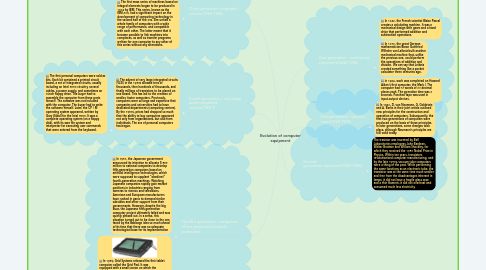Evolution of computer equipment
by Кирилл Шарнин

1. Third generation-integrated circuits (1965-1980)
1.1. The invention of the silicon integrated circuit in 1958 by Jack Kilby and Robert Noyce allowed dozens of transistors to be placed on one small microcircuit. Integrated circuit computers were smaller, faster, and cheaper than their transistor predecessors.
1.2. The first mass series of machines based on integral elements began to be produced in 1964 by IBM. This series, known as the IBM-360, had a significant impact on the development of computing technology in the second half of the 60s. She united a whole family of computers with a wide range of performance, and compatible with each other. The latter meant that it became possible to link machines into complexes, as well as transfer programs written for one computer to any other of this series without any alterations.
2. Fourth generation - very large scale integrated circuits(1980-?)
2.1. The advent of very large integrated circuits (VLSI) in the 1980s allowed tens of thousands, then hundreds of thousands, and finally millions of transistors to be placed on one board. This has led to the creation of smaller, faster computers. Previously, computers were so large and expensive that companies and universities had to have dedicated departments (computing centers). By the 1980s, prices had dropped so much that the ability to buy computers appeared not only from organizations, but also from individuals. The era of personal computers has begun.
2.1.1. The first personal computers were sold as kits. Each kit contained a printed circuit board, a set of integrated circuits, usually including an Intel 8080 circuitry, several cables, a power supply, and sometimes an 8-inch floppy drive. The buyer had to assemble the computer from these parts himself. The software was not included with the computer. The buyer had to write the software himself. Later, the CP / M operating system appeared, written by Gary Kildall for the Intel 8080. It was a complete operating system (on a floppy disk), with its own file system and interpreter for executing user commands that were entered from the keyboard.
3. The fifth generation - computers of low power and invisible computers
3.1. In 1981, the Japanese government announced its intention to allocate $ 500 million to national companies to develop fifth-generation computers based on artificial intelligence technologies, which were supposed to supplant "obedient" fourth-generation machines. Watching Japanese companies rapidly gain market positions in industries ranging from cameras to stereos and televisions, American and European manufacturers have rushed in panic to demand similar subsidies and other support from their governments. However, despite the big buzz, the Japanese fifth-generation computer project ultimately failed and was quietly phased out. In a sense, this situation turned out to be close to the one faced by the Babbage idea so much ahead of its time that there was no adequate technological base for its implementation
3.2. In 1989, Grid Systems released the first tablet computer called the Grid Pad. It was equipped with a small screen on which the user could write with a special pen. Systems such as the Grid Pad have demonstrated that a computer does not have to stand on a desk or in a server room — the user can carry it around, and with a touch screen and handwriting recognition it becomes even more convenient
4. Zero generation - mechanical computers(1642-1945)
4.1. In 1642, the French scientist Blaise Pascal creates a calculating machine. It was a mechanical design with gears and a hand drive that performed addition and subtraction operations.
4.2. In 1672, the great German mathematician Baron Gottfried Wilhelm von Leibniz built another mechanical machine that, unlike the previous one, could perform the operations of addition and division. We can say that Leibniz created something like a pocket calculator three centuries ago.
4.3. in 1944, work was completed on Howard Aiken's first computer, the Mark I. The computer had 72 words of 23 decimal places each. The operation time was 6 seconds. Punched tape was used in input-output devices.
5. First generation - vacuum tubes(1945-1955)
5.1. In 1946, D. von Neumann, G. Goldstein and A. Berks in their joint article outlined new principles for the construction and operation of computers. Subsequently, the first two generations of computers were produced on the basis of these principles. In later generations, some changes took place, although Neumann's principles are still valid today.
6. Second generation-transistors(1955-1965)
6.1. The trasistor was invented by Bell Laboratories employees John Bardeen, Walter Brattain and William Shockley, for which they received the 1956 Nobel Prize in Physics. Within ten years, transistors revolutionized computer manufacturing, and by the late 1950s, vacuum tube computers were a thing of the past. While performing the same functions as an electronic tube, the transistor was at the same time much smaller and free from the disadvantages inherent in lamps: it did not have a fragile glass case and a thin filament, it did not overheat and consumed much less electricity.


